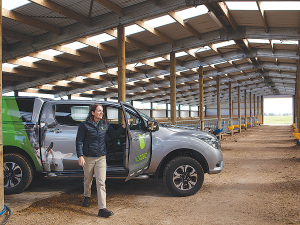Get ready for Moving Day
Moving Day is a big day in the farming calendar and requires good planning and communication to ensure success.
 NZAgbiz’s Carla Rawson says now is a good time to put a plan into place for the upcoming calving season.
NZAgbiz’s Carla Rawson says now is a good time to put a plan into place for the upcoming calving season.
With calving fast approaching, dairy farmers and calf readers are planning for the busy months ahead. But NZAgbiz suggests that planning for long term productivity and profitable returns is about much more than preparing to cope with the demands of the season.
Good planning leads to long term success, and it’s especially important when it comes to the busy peaks when there’s less time to make improvements on the fly, it says.
Leading into this year’s calving season, good decisions made early, will ensure you are well placed to not only make the most of the payout from a record farm gate milk price, but to make sure 2024 heifers reach their full potential.
“It’s not easy to think about colostrum quality and its effect on immunity and health in the middle of long days and nights when calving gets into full swing,” says NZAgbiz’s Carla Rawson.
“Often, there just isn’t the time to spend to consider feed options, setting target weights and their effect on heifers’ future productivity and reproduction when the pens are filling up. Which is why now is the right time to think about these things and to put a plan in place.”
For most farmers, the planning starts with the big numbers – this season’s payout. So for many of those keeping an eye on the figures, the decision has already been made to maximise their return this season by choosing not to feed out of the vat.
Matamata farmers, Robert and Sharon Klaus, have calculated that feeding their calves a quality milk replacer will mean an estimated $12,500 increase in payout this year.
“It’s a simple formula,” says Robert.
“Based on our volumes and kgMS per litre, when you subtract the cost of the Ancalf, we see that we’d otherwise be feeding thousands of dollars of profit to the calves.”
There’s a calculator on the NZAgbiz website that crunches the numbers.
Rawson says the calculator is proving pretty popular.
“We’re seeing hundreds of farmers using it as they make decisions and get their plans and orders sorted.”
There is however a limit to how much planning in any one season can affect returns and overall herd productivity.
Farmers are, of course, making decisions today that will affect their operation for years to come. A lot of those decisions are about future production and future reproduction – which requires careful consideration of the connection between animal growth rates, weight, and condition and effects on the animal’s potential, notes Rawson.
Research indicates that weight gain pre-weaning is connected to an animal’s lifetime productivity. Industry experts suggest that setting a calf up for success is more important than was previously realised. The data supports feeding calves well will have an impact on mammary gland development and therefore future production of those animals once they enter the herd.
“There is a lot to consider when rearing calves to their full potential so we make sure we’re guided by the science when we’re talking with our customers,” Rawson says.
“What we know is that young calves need high quality colostrum as early as possible to ensure a successful transfer of antibody molecules, which leads to better long-term immunity and health.
“And we also know that whole milk and whole milk based milk replacers are like nature intended, which is connected to healthy gastro-intestinal tract development and better growth rates.”
The secret to whole milk’s positive effects on young animal development is in its casein-rich protein which allows the milk to curd as well as the fatty acid profile of milk fat. A high-quality curd allows more complete digestion and better nutrient uptake.
“When we spend time with our customers, we end up getting into interesting conversations about the research and calves’ digestive systems,” says Rawson. “But it always comes down to one thing – making good decisions about the future.
“Future payout, long term animal health, future productivity, future herd performance: that’s why we’re here – we want to help our farmers to plan for continual improvement and their herd’s success.”
South Waikato farm manager Ben Purua’s amazing transformation from gang life to milking cows was rewarded with the Ahuwhenua Young Maori Farmer award last night.
Bankers have been making record profits in the last few years, but those aren’t the only records they’ve been breaking, says Federated Farmers vice president Richard McIntyre.
The 2023-24 season has been a roller coaster ride for Waikato dairy farmers, according to Federated Farmers dairy section chair, Mathew Zonderop.
Ministry for Primary Industries (MPI) director general Ray Smith says job cuts announced this morning will not impact the way the Ministry is organised or merge business units.
Scales Corporation is acquiring a number of orchard assets from Bostock Group.
Family and solidarity shone through at the 75 years of Ferdon sale in Otorohanga last month.
OPINION: Scientists claim to have found a new way to make a substitute for cow's milk that could have a…
OPINION: The Irish have come up with a novel way to measure cow belching, which is said to account for…